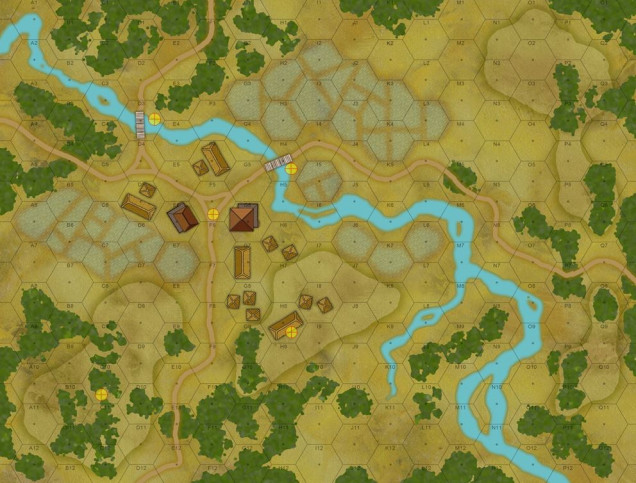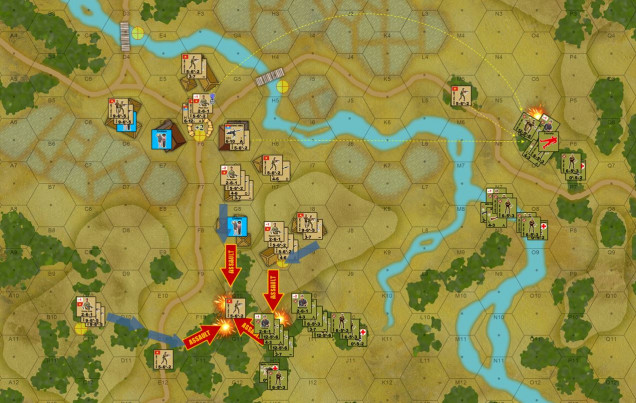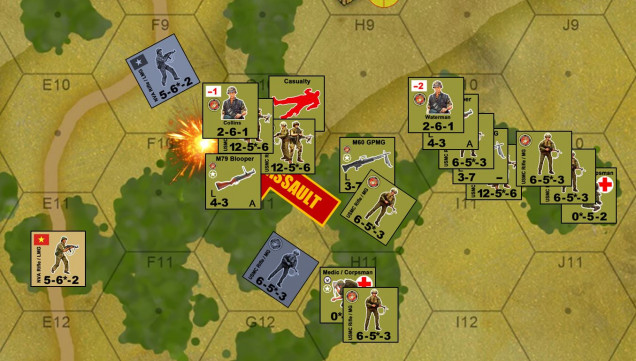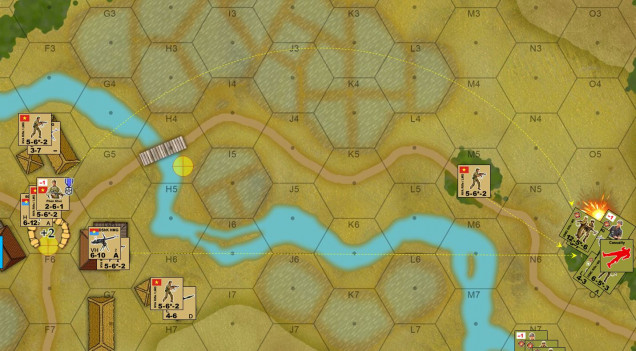
Hürtgen Forest - Game Video
USMC vs. NVA, Hill Battles of Vietnam, 1967
Good morning, OnTableTop / Beasts of War!
Okay, as you may know, we’ve been running war games every weekend with members of the community via web conference. Players log on and play wargames with each other in real time, regardless of location, and we usually have at least a couple spectators as well. Many times it’s been Darkstar, but we’re also running wargames in Panzer Leader, Arab-Israeli Wars, and now Valor & Victory, the squad-based command-tactical wargame designed and published by Barry S. Doyle.
Originally written for World War II as sort of a “spiritual love letter” to the 1980s classic Advanced Squad Leader, Valor & Victory takes everything that was great about that game (but got perhaps a little too complex and cumbersome in later variants) and boils it down to a fast, pick-up-and-play system that the community (especially on BoardgameGeek) has embrace to update, add to, create new scenarios, units, and maps, and generally have a great time with.
Well, as you may remember from the Tet Offensive 50th Anniversary series we ran last January and February, I was able to rebuild Valor & Victory to play Vietnam era games, complete with US Army, US Marine, US Military Police, ANZAC, ARVN (Army of Republic of Vietnam), NLF (National Liberation Front, or Viet Cong), and PAVN (People’s Army of Vietnam, or NVA) forces.
So Saturday, Rasmus and I ran a Valor & Victory game in Vietnam. He took the NVA, trying to hold a “hill country” village with a detachment of the 320th NVA Division, I took Lima Company, 3rd Battalion, 4th Marines (3rd Marine Division) in an attempt to clear the village. This battle took place near Marine Corps firebases of “the Rockpile,” Camp Carroll, and Cam Lo, dear the supposedly “Demilitarized Zone” that formed the border between North and South Vietnam. The date is sometime in late 1967, during the period called the “hill fights,” where NVA divisions increasingly leveraged into position from North Vietnam and Laos via the Ho Chi Minh Trail, setting up for the imminent “Tet Offensive” that would strike on January 30-31, 1968 (leading to famous battles like Lang Vei, Khe Sanh, and of course Hue City).
So here is the imminent battlefield. Rasmus will set up his NVA force (89 officers and men) wherever he wants. I will come on anywhere on the eastern edge, or the eastern half of the northern and southern edges. The mission is simple. Control of the five objective hexes marked with yellow targeting symbols. These are buildings, bridges, and high ground that Marine Regimental HQ has deemed are important for continuing operations to deny positions the NVA will want for artillery batteries, rocket positions, and artillery spotters in the ongoing “Hill Country” battle around these Marine Corps fire bases.
Very quickly, here are the victory conditions: As usual for Valor & Victory, the game lasts 6 turns. The Marines get 1 point for each NVA fireteam or officer eliminated, 3 points if I can take them prisoner and successfully get them off the board. The NVA get 3 points for every fireteam or officer (or Navy Corpsman) eliminated, 6 points if any of these casualties are “unsecured” (left bleeding on the battlefield or even worse, if they fall into NVA hands). The Marines also lose 6 victory points if they hit any civilians. At the end of the game, the each s ide also gets 3 points for every objective counter they still hold. The Marines also have to watch out for booby traps, and of course the “burden of victory” is on them as the NVA start out holding all five objective hexes.
Now this sounds terribly unfair to the Marines. But in fact the Marines are much more powerful, better armed, better equipped, and have off-board artillery support. In all my force contains 84 officers and men, and includes satchel charges, 24 M60 GPMGs, 4 M79 40mm grenade launchers, off-board 81mm mortars. The NVA are well equipped as well, with a captured American 60mm mortar, a DShK .50 cal heavy machine gun, plenty of PKM GPMGs, and three B-40 / RPGs.
The game begins as the Marines enter the board. I have two platoons coming on from the south (Captain Waterman, 2ndLt Collins) and two more platoons from the east (Lts. Pierce and Bergman).
Things kick off in a very big way … right off the bat.
This is going to take a while to unpack, as a lot happens. Suffice it to say that the NVA put up some very serious fire in the north and in the south, Lt. Collins’ platoon is immediately in the thick of a very serious battle for their lives. As they launch an assault on an NVA scout fireteam, they will then counter-assaulted from three directions. This will the main action of Turn 1, so we’ll break it down in a little more detail.
First comes Collins’ assault on that NVA spotter platoon. Probably not the best move I’ve ever made, as I should have tried to pin him down first. But since you can’t move and fire in the same turn in this game, pinning down enemy units for an assault requires either a fire and maneuver element (one platoon pins, another platoon carries in the assault), or wait until next turn.
Splitting up my squads into individual fireteams (dilutes my striking power due to stacking limitations but makes my units more resilient to casualties, basically my men are spreading out in their assault), I still have to leave one fireteam pinned to NVA opportunity fire, and then lose another fireteam in the assault itself. The position is taken, but it probably cost me too much, especially since Rasmus (on his turn 1) will be counter-assaulting from three directions.
Further north, Lt. Pan Khoi with the mortar positively nails his check, with a “snake eyes” roll that pins down almost Pierce’s whole platoon (the Americans have to keep casualty points down in these Vietnam games, so I’m electing to pin down many more of my units rather than let far fewer of them actually be eliminated. The DShK also opens up, although that does far less damage. The scout fireteam of NVA rifleman (AKM assault rifles / SKS battle rifles and one PKM GPMG) also add to my problems on the Marine northern wing.
Ever see the final scene of Platoon? Well, Rasmus has decided that will be the start of this little movie instead of the end.
So first we have Lt. Huang Giap attack from the southwest, rushing in with his two squads plus the scout fireteam he picked up from the jungle trail along the way. I pin one fireteam down with opportunity fire, but the rest of the attack goes in. He invests two grenades from his pool, as do I. The assault is broken, and the NVA force is wiped out (except that one pinned fireteam because they didn’t actually participate in the assault).
But I’m down three casualty points as a result, forcing me to kill off one of my fireteams (half of one of this 12-5-6 squads).
This only softens up Lt. Collins’ position for the bigger assault coming down from the south, led by the NVA commander, Captain Jiang Xuan. I cannot throw in in more opportunity fire, I already fired at Giap’s platoon to the southwest. Again Rasmus tosses in two grenades, I have to toss in a grenade and (in a desperate attempt to save myself), a satchel charge. This assault is also broken, wiping out the NVA force (Marine firepower is nothing to scoff at), but the casualty points are so high that Collins’ position basically wiped out as well.
Finally we have Lt. Nguyen Trai’s assault to the east. Now this starts out bloody for me off the bat, as I have a pinned fireteam in the target hex. Once that hex is assaulted, that pinned unit is killed automatically. The rest of the Marines in the hex fight desperately (Lt. Trai is pinned down before his assault even goes in), throwing in yet more grenades and the last of my satchel charges, countered by yet more grenades from the NVA. This assault actually succeeds, but without Trai leading it, losses are so high that it’s basically annihilated as well. Trai is ironically the only “combat effective” man left in that platoon.














































































Leave a Reply